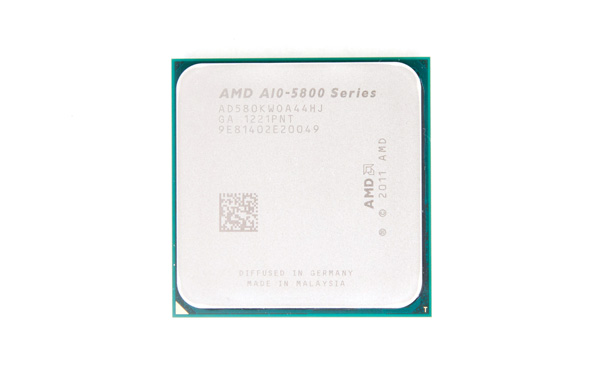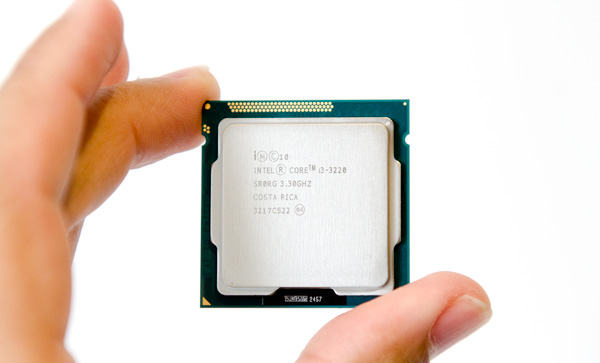AMD A10-5800K & A8-5600K Review: Trinity on the Desktop, Part 2
by Anand Lal Shimpi on October 2, 2012 1:45 AM ESTAlthough AMD's second-generation mainstream APU platform, codename Trinity, launched months ago in notebooks the official desktop launch is today. Rumor has it that AMD purposefully delayed the desktop Trinity launch to clear out unsold Llano inventories in the channel. Although selling APUs in notebooks is pretty easy, convincing desktop users to forgo the discrete GPU option (and ignore Intel) has been a tough battle for AMD. I keep going back to two slides that show us where AMD wants to go and the cores it'll take to get there:

The ultimate goal is this beautiful cohesive operation between CPU and GPU on a single die. That future will require a lot of software support, not only at the application level but also at the OS level. And I'm not talking about Windows 8. We're still far away from this APU dominated future, but AMD is marching in that direction. The second slide shows the x86 cores that we'll see from AMD along the way. AMD is still playing catch-up in the x86 CPU space and it's got a lot of lost time to make up for. There's no hiding the fact this is going to be a multi-year effort to simply get close to Intel's single-threaded x86 performance. Through pricing, leveraging its GPU technology and throwing more transistors at the problem AMD can still deliver competitive solutions, but it's not going to be a walk in the park.
Last week we took a look at the GPU side of the desktop Trinity APUs. We looked at the top end 384-core Radeon HD 7660D configuration as well as the slightly slower 256-core Radeon HD 7560D GPU, both of which easily outperformed Intel's HD 4000 and HD 2500. As far as processor graphics go, Trinity on the desktop maintains a healthy lead over Intel. There's still a place for discrete GPUs but that's pretty much at the $100 and above price points.
Today we're able to talk about pricing and x86 CPU performance among other things. The good news on that front is the most expensive Trinity APU is fully unlocked and is priced at $122:
| AMD Socket-FM2 Lineup | ||||||||
| Modules/Cores | CPU Clock Base/Turbo | L2 Cache | GPU | TDP | Price | |||
| A10-5800K | 2 / 4 | 3.8 / 4.2 GHz | 4MB | 384 cores @ 800MHz | 100W | $122 | ||
| A10-5700 | 2 / 4 | 3.4 / 4.0 GHz | 4MB | 384 cores @ 760MHz | 65W | $122 | ||
| A8-5600K | 2 / 4 | 3.6 / 3.9 GHz | 4MB | 256 cores @ 760MHz | 100W | $101 | ||
| A8-5500 | 2 / 4 | 3.2 / 3.7 GHz | 4MB | 256 cores @ 760MHz | 65W | $101 | ||
| A6-5400K | 1 / 2 | 3.6 / 3.8 GHz | 1MB | 192 cores @ 760MHz | 65W | $67 | ||
| A4-5300 | 1 / 2 | 3.4 / 3.6 GHz | 1MB | 128 cores @ 724MHz | 65W | $53 | ||
| Athlon X4 750K | 2 / 4 | 3.4 / 4.0 GHz | 4MB | N/A | 100W | $81 | ||
| Athlon X4 740 | 2 / 4 | 3.2 / 3.7 GHz | 4MB | N/A | 65W | $71 | ||
Compare this to Llano's launch where the top end SKU launched at $135 and you'll see that AMD is somewhat getting with the times. I would still like to see something closer to $100 for the A10-5800K, but I find that I'm usually asking for a better deal than what most CPU makers are willing to give me.
AMD's competitive target is Intel's newly released Ivy Bridge Core i3 processors. There are only five Core i3s on the market today, four of which use Intel's HD 2500 graphics. The cheapest of the lineup is the Core i3 3220 with two cores running at 3.3GHz for $125. Intel disables turbo and other features (there's effectively no overclocking on these parts), which AMD is attempting to exploit by pitting its Trinity K-series SKUs (fully unlocked) against them. AMD's TDPs are noticeably higher (100W for the higher end K-series parts compared to 55W for the Core i3s). Intel will easily maintain the power advantage as a result under both CPU and GPU load, although AMD's GPU does deliver more performance per watt. Power consumption is a major concern of AMD's at this point. Without a new process node to move to for a while, AMD is hoping to rely on some design tricks to improve things in the future.
At the low end of the stack there are also two Athlon X4s without any active GPU if you just want a traditional Trinity CPU.
The Test
This will be our last CPU/APU review on the current test platform/software configuration. The next major CPU review will see a move to a brand new testbed running Windows 8. As always you can get access to far more numbers than what we report here if you use our performance comparison engine: Bench. Of course if you want to see the GPU and GPU Compute performance of AMD's Trinity APU check out part one of our coverage.
| Motherboard: |
ASUS P8Z68-V Pro (Intel Z68) ASUS Crosshair V Formula (AMD 990FX) Gigabyte GA-F2A85X-UP4 (AMD A85X) Intel DZ77GA-70K (Intel Z77) |
| Hard Disk: |
Intel X25-M SSD (80GB) Crucial RealSSD C300 OCZ Agility 3 (240GB) |
| Memory: | 2 x 4GB G.Skill Ripjaws X DDR3-1600 9-9-9-20 |
| Video Card: |
ATI Radeon HD 5870 (Windows 7) AMD Processor Graphics Intel Processor Graphics |
| Video Drivers: | AMD Catalyst 12.8 |
| Desktop Resolution: | 1920 x 1200 |
| OS: | Windows 7 x64 |













178 Comments
View All Comments
Hubb1e - Tuesday, October 2, 2012 - link
Atom falls down with Netflix and idles around the same point as these chips.mattlach - Thursday, October 4, 2012 - link
My current AMD E-350 can not handle Netflix HD, which is disappointing.The way Netflix has implemented DRM in Silverlight, hardware decode acceleration doesn't work on any system, so it all hits the CPU, and many lower end systems (Atom, E-350) just can't handle it above SD resolutions.
Everything else I've tried (Youtube, custom encoded video files, etc. etc., habe not tried Hulu though) works just fine, as the on-chip GPU offloads the CPU and they play fine, but Netflix HD chokes, and chokes badly.
Thus the need for a low end, power efficient Trinity setup.
I would love one of those mobile Trinity chips in a desktop FM2 package. A 35W TDP Trinity or lower would be perfect for my HTPC needs.
stimudent - Tuesday, October 2, 2012 - link
We need to appreciate and thank anandtech.com for being professional about a staged release. This is in stark contrast to taking part in cry baby journalism that TechReport.com engaged in.Pythias - Tuesday, October 2, 2012 - link
"Professional" is a polite euphemism for prostitute in some circles.Pythias - Tuesday, October 2, 2012 - link
Why did you remove the pentium from the descrete gaming chart?Hubb1e - Tuesday, October 2, 2012 - link
Because he wanted to keep the forums ripe for the trolls who think a Celeron plus a 6670 are faster than Trinity.Pythias - Wednesday, October 3, 2012 - link
Seems rather dodgy.HisDivineOrder - Tuesday, October 2, 2012 - link
Hopefully, one of these days, Intel will be bothered enough by these APU's that they release an i3 with boost and an unlocked multiplier with the higher end version of the integrated GPU.Price it right at the high end of AMD's APU lineup, bam, the whole thing is dead in the water. I suspect Intel wants AMD to seem like they're competition to keep the regulators away, so they're holding back on the obvious killshot.
mikato - Wednesday, October 3, 2012 - link
It would somewhat kill their higher priced CPUs also though.eanazag - Tuesday, October 2, 2012 - link
I wasn't expecting AMD to close the performance gap or power usage gap with Intel. I was concerned that it might not even be able to beat Llano CPU performance consistently. I feel comfortable with the CPU performance. I think at even lower pricing AMD could dominate the low end market. I have a Core i5 860 and Core i3 Arrandale (same time frame). I certainly noticed the 860 appearing in the benchmark numbers. The A10 Trinity is not too far off the performance of my 860, especially when considering price in factors. And off the FX-8150 it has pretty good performance, which is a decent sign for the higher end AMD desktop parts coming soon (can't really call the AMD high end parts).Idle power usage is excellent. Power usage can make sense for AMD if you are considering a cheap Intel proc and a discrete card. I think in that situation AMD makes more sense.
Drivers and support go to AMD on both sides of software compatibility (AMD drivers and game support).
SATA 6Gbps on Intel with just 2 builtin ports still upsets me. This should be an advantage for AMD at the platform level.
I want to see the desktop and server chip data next. I am glad that I don't have to rule out buying the AMD parts from the get go. The buying decision will still be that.
I still believe AMD should make a 200W part combining their FX proc with a 7700/7800 range GPU. I think they could dominate the midrange with that and who could compete then? From price and gaming performance at least. Power and heat still makes sense considering the removal of that level GPU from the case. Hell, I could deal with 250W and be happy also.